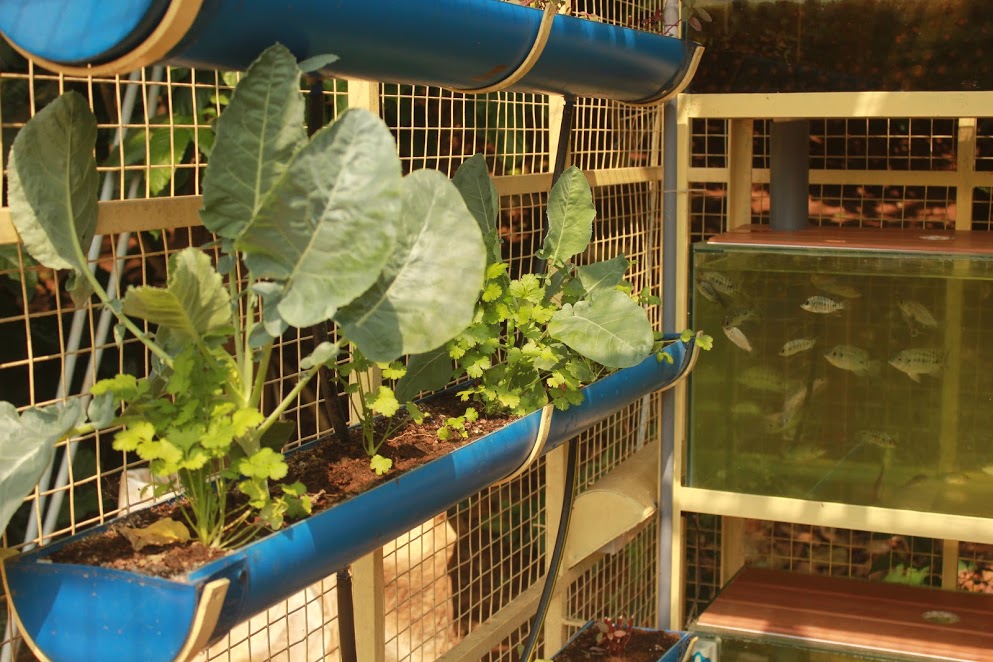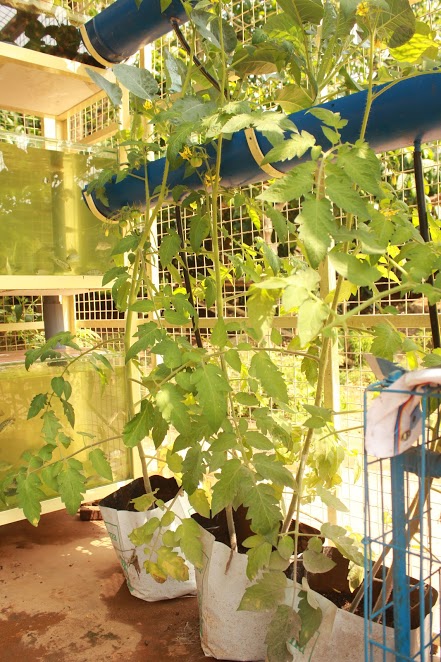This Space-Savvy Integrated Farming Unit Lets You Grow Fish, Poultry & Vegetables Organically
Many urban dwellers are unable to take up farming, especially poultry and aquaculture, due to want of space and time. It was to address these issues that the Centre for Wildlife Studies (CWS) at Pookode, under the Kerala Veterinary and Animal Sciences University, created an integrated capsular farming concept titled I-farm.

At present, there is a huge demand for organic farming in the country especially after recent reports surfaced, warning that vegetables containing high levels of chemicals and toxins are being sold in the market. Many urban dwellers have even taken up kitchen gardening although their efforts are often restricted due to constraints of space and time.
Now, the Centre for Wildlife Studies (CWS) at Pookode, under the Kerala Veterinary and Animal Sciences University, has come out with an integrated capsular farming concept titled I-farm to address these issues.

The farming unit is based on the principles of Integrated Aquaponics, a technique that marries horticulture, aquaculture and poultry farming to help farmers raise fish and hens while also growing plants.
“The idea originated when I decided to start farming for my family at my home in Wayanad. The thriving monkey population in the area meant that my vegetable gardens were often uprooted and destroyed by their visits.
“I wanted to design a way of farming that would help families grow food for themselves without obstructing or relocating wild animals. So I did some research, tried aquaponics at home and designed a unit for this purpose. Next, I pitched the design to the Kerala Veterinary and Animal Sciences University,” says the officer-in-charge, a veterinary surgeon at the Centre for Wildlife Studies at Pookode.
The 8x5x6 feet welded-mesh shed of an I-farm unit houses an aquaponics unit (consisting of two aquaria), a poultry unit and one tray for growing vegetables. In an I-farm, the water from the aquaria is directly used to grow plants in submerged gravel beds. Rainwater harvested through channels can also be utilised in this system. Vegetables are grown in PVC channels fixed to both the sides of the unit and grow-bags with standard potting mixtures.

Simply put, aquaponics create an efficient and environmentally-friendly system to farm fish and plants together in a mutually beneficial cycle. Fish are kept in large tanks and the plants are grown hydroponically (without soil). They are planted in beds, with a little gravel or clay, and their roots hang down into the water. The gravel serves as a home to nitrifying bacteria that convert ammonia to nitrites and then to nitrates.
The water is cycled through the system, so that it collects “waste” from the fish. This waste is turned into nitrates by microbes. Although a build up of nitrates aren’t good for the fish, they work as a great fertiliser for plants. Nutrient-rich water is then pumped to the plant beds, where it is filtered naturally by plants and can then be returned to the fish tanks.

Unlike traditional farming methods, no chemical fertilisers are needed for plants: they all come from fish-waste. It is necessary to stay organic, because the use of pesticides are damaging to the fish. Per square foot, it’s one of the most productive forms of agriculture and is a perfect example of a self-sufficient assembly of plants and animals that function like an ecosystem, producing food for people without creating waste products or pollution.
The I-Farm unit also consists of an Aishwarya poultry unit to house the Athulya White Leghorn breed of poultry. Each hen lays more than 300 eggs per year. The Aishwarya project is aimed at helping urban residents keep poultry in the limited space available with little or no odour. The cages given under the project are equipped with an automatic drinking system that provides water to the birds for one week. Each cage has an egg tray, a protective cover, a PVC sheet to collect bird droppings to be used as manure, and a stand. To prevent bad odour, a specially formulated acidifier deodoriser spray is also provided.
The I-farm also has a simple compost unit to ensure the convenient management of poultry manure and kitchen waste. Poultry manure is very high in nitrogen and also contains a good amount of potassium and phosphorus. However, the high nitrogen in chicken manure is dangerous to plants if the manure has not been properly composted. Untreated chicken manure used as fertiliser can burn, and even kill plants. Composting chicken manure mellows it’s nitrogen content and makes it more suitable for the garden.
You May Like: Super Greens: How to Grow Nature’s Own Super Food at Home
To further increase the productivity of the unit, the roof of the I-Farm has been made of welded mesh that can be used to grow a green roof of flower, vegetable or fruit-bearing climbing plants such as passion fruit. The entire unit can be easily installed (and dismantled) on the roof of terraced buildings, small courtyards or in the kitchen garden.

The I-farm is dedicated to sustainable farming and is aimed at bringing out the farmer in each of us. “The ‘I’ in the name stands for three things: an Individual who farms for his family; Intelligent, referring to the unit’s ability to maximise productivity while minimising wastage; and Integrated referring to how it combines the rearing of poultry with aquaculture and organic agriculture,” says the officer-in-charge, adding that the unit can be easily customised.
“There’s a lot that can be added to this unit. Let your imagination decide where to stop. For instance, one can place a nesting box for sparrows inside, with an entrance and exit from the I-farm. If a house sparrow family decides to settle, they may help pick out worms that can harm your plants and support your organic adventure! You would also have played your part in sparrow conservation!”
The Kerala Veterinary and Animal Sciences university aims at making the unit available to all families interested in growing their own food at a reasonable price. Each I-farm unit costs ₹35,000 and this includes all components from seeds to supplies. However, the demand for the units is already outweighing the supply. The University has installed pilot units on its campus to demonstrate how integrated capsular farming works and to encourage interested individuals to take it up.
Some of the I-farm units have also been distributed to tribal communities to help them supplement their meagre incomes. The introduction of I-farm units has also encouraged peaceful co-existence of people with wild animals in Wayanad, by allowing the cultivation of crops and the production of eggs in human-wildlife conflict areas.
For details, contact [email protected] or [email protected]. Here’s the link to the website of the Kerala Veterinary and Animal Science University.
Also Read: Growing Soil-Less With Hydroponics: An Introduction to Innovative Farming at Home
Like this story? Have something to share? Email: contact@thebetterindia.
NEW! Log into www.gettbi.com to get positive news on Whatsapp.
This story made me
- 97
- 121
- 89
- 167
Tell Us More
We bring stories straight from the heart of India, to inspire millions and create a wave of impact. Our positive movement is growing bigger everyday, and we would love for you to join it.
Please contribute whatever you can, every little penny helps our team in bringing you more stories that support dreams and spread hope.



















